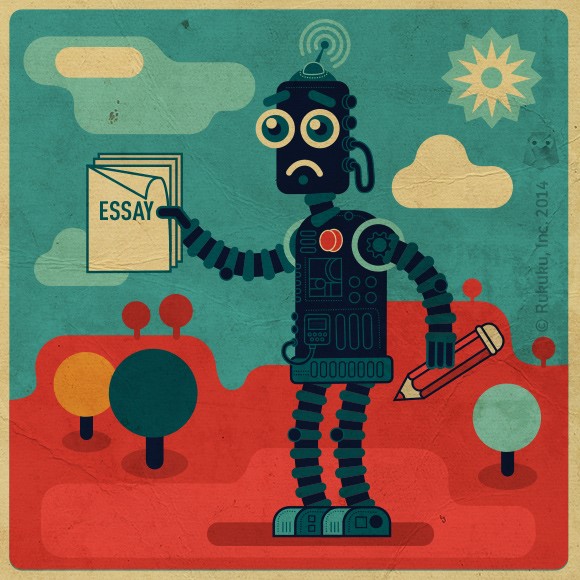Wow! SXSW2014 is an amazing experience through and through. Our booth at the trade show was very well attended. We have started conversations with many potential partners and customers: training businesses and organizations, corporate trainers and HR departments in large corporations. The press is also very active at the trade show. All in all, it has been 14 hours of non-stop action today! We already know we will be back for next year’s SXSW – the event is that good!
SXSW 2014, Austin, TX
Technology, Tests, and the Art of the Essay
Should computers grade essays?
The Common Core is trying to shift the emphasis of education toward more complex forms of thinking. Evaluating more complex thinking, however, requires more complex forms of assessment. I think most people would agree that written essays are better indicators of a students’ understanding than multiple choice, fill-in-the-bubble tests, but they are also more time-consuming and expensive to mark. Multiple choice tests can be fed into a computer and instantly graded, whereas essays require a teacher or professor or test center professional to read and evaluate them. Or maybe they don’t.
Several studies in recent years, like this one for example, have shown that computers can mark essays with the same accuracy and consistency as humans. In fact, computers are often more consistent than human readers. As states struggle to put together new assessments, without breaking budgets, computerized essay grading holds some obvious attraction. Namely, it’s much cheaper.
But it is also controversial and it’s not hard to imagine why. Computers can’t really measure creativity or originality. And the values placed on certain features, like longer words and more complex phrases, open possibilities for manipulating the scoring system. To see more on this argument, check out this statement from the National Council of Teachers of English (NCTE).
What do you think, dear readers? Do you see any problems with computers grading essays? Leave comments below!
Infographic of the Week: Scholarships Demystified
Thanks to Fluidreview for the infographic. Check out the original here.
Hot for Teaching: Education Attracts More Qualified Candidates
Teaching is attracting better qualified candidates. That is the conclusion of a study by Dan Goldhaber and Joe Walch of the Center of Education Data and Research (CEDR). In this article published in the Winter 2014 issue of Education Next, Messrs. Goldhaber and Walch not only discuss the results of their research but also outline the historical trends that led to the initial decline in the academic qualifications of teachers.
The story goes something like this. A few decades ago, teaching was the most popular career choice for well-educated women. Then came the women’s liberation movement, and new opportunities in varying fields pulled qualified women away from teaching. The talent pool shrank, and academic qualifications for teachers overall fell.
To illustrate, the percentage of teaching candidates graduating in the top 10% of their high school class declined from 25% in 1964 to 11% in 2000. During the same time period, the percentage of teachers that scored in the lowest 60% in standardized testing increased from 32-35% to 42%. Check out that research here.
Then came No Child Left Behind, passed in 2001. The law put in several new requirements on teaching, like making teachers complete certain required courses or pass competency tests in the subject areas which they teach. NCLB also introduced a ton of new testing. Many predicted that the stricter requirements and emphasis on testing would deter qualified candidates from applying.
The research presented in the article, however, suggests the opposite trend. Teacher qualifications are improving. Unlike in the mid-1990s and early 2000s, graduates entering the teaching profession had slightly higher SAT test scores on average than peers entering other professions. Those teachers scored in the 50th percentile in 2008-09, compared to the 45th percentile and 42nd percentile for new teachers in 1993-94 and 2000-01 respectively.
New teachers also spend more time in school than in the past. The number of teachers holding master’s degrees increased from 47% to 51% from the 1987-88 school year to the 2007-08 year, and the percentage of prospective teachers formally training in graduate programs rather than undergraduate programs rose from around 45% in 1990 to 63% in 2010.
Can we take encouragement from these figures? Maybe. The numbers are somewhat outdated and may reflect tougher economics conditions rather than stronger interest among qualified applicants. Teaching could be a more attractive option only because it offers more security and more opportunities in a challenging job market. At the same time, these are long term trends and figures from 2008 would only reflect the very beginning of the financial crisis.
What do you think? What’s behind the rise in the number of qualified teachers? Please let us know in the comment section below.
Cool in School: Socialization and Technology in the classroom
I’m a social person. I’m also a little nerdy. For those reasons, one point in particular stood out for me in our recent interview with Michael Horn. His experiences observing technology in the classroom suggest that, rather than isolating students, personalizing education has contributed to a sort of learning-centered socialization.
Here’s why. While kids may be plugged into individual monitors, studying lessons personalized to their individual strengths and weaknesses, they still jump up now and then to help each other out. As Mr. Horn points out, that’s a much healthier type of socialization than most of us experienced when we were younger.
It’s a nice image, right? Students chatting away in class, not about the school dance, the weekend football game, or so-n-so’s new boyfriend, but about math and history and school subjects instead. Ok, maybe not instead, but in addition to sports, social events, and gossip, maybe more students will talk about school subjects. This could be the development that nerdy kids around the world have been waiting for. Those students that understand class material and are willing to help others will have many more opportunities to socialize.
There are some big assumptions there, though. One is that teachers will allow such socialization to take place. That means a looser classroom environment with which some teachers may not be comfortable. Second, kids are competitive, especially academically oriented ones. Taking time to peer tutor other students may be less attractive as kids get older and competition for top spots intensifies.
Even with those considerations in mind, I am still hopeful. Is it possible that being a good student in school could turn into a social asset in grade school rather than a liability? Or is that just the wishful thinking of a nerdy guy? I’m interested to hear thoughts from our readers. To what extend does academic strength improve, impair or have absolutely nothing to do with grade school socializing? Is technology changing it?




